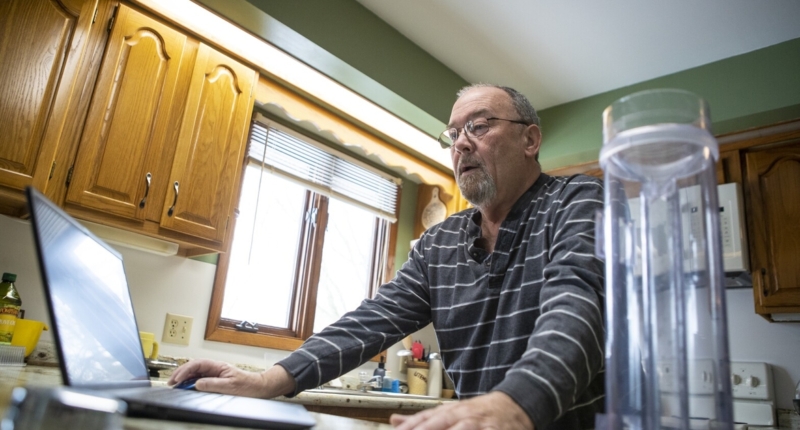Paul Larson is a dedicated volunteer observer for the Community Collaborative Rain, Hail and Snow Network (CoCoRaHS), providing daily precipitation reports for decision-making purposes. Larson’s interest in science and the environment was inspired by his high school environmental science teacher, Ron Erpelding. Larson reports daily, even during dry spells, and provides his data year-round, which is essential for assessing drought conditions. Larson’s commitment to being a CoCoRaHS observer is a testament to the importance of citizen science and how anyone can contribute to the scientific community by volunteering their time and expertise. Anyone interested in becoming a CoCoRaHS observer can visit the CoCoRaHS website to learn more.
Citizen Science and the Importance of CoCoRaHS Observers
In farm country, backyard rain gauges are as ubiquitous as were six-shooters in the Old West, and maybe just as important. Backyard weather enthusiasts like Paul Larson of Spicer can tell you how much rain or snow has fallen in their area thanks to their participation in the Community Collaborative Rain, Hail and Snow Network, or CoCoRaHS. CoCoRaHS is a national network of volunteers who provide daily precipitation reports, which are used by a variety of organizations and individuals for everything from studying the climate to making decisions for agriculture and mosquito control.
According to Michelle Margraf, meteorologist and observing program leader with the National Weather Service in the Twin Cities, the information collected by CoCoRaHS observers is important. Currently, the data collected by the observers is helping the National Weather Service track the snow melt and the water content to assess the danger of spring flooding. There are currently 2,001 CoCoRaHS observers in Minnesota, but there is a need for more observers in Greater Minnesota, where there are large areas without observers.
Getting good information depends on having as many observation locations as possible. The more pixels—or in this case, the more weather observers—the better. Weather matters to Larson, which is why he decided to become a volunteer for CoCoRaHS after he retired from a career in human services. Larson’s interest in the weather dates back to the summer of 1973, when he stepped on the deck of a Johnson Sea Scow sailing boat and unfurled its sail to the winds rippling the waters of Green Lake. He’s been hooked on sailing ever since and has never missed a summer of sailing since. When ice conditions allow, he also takes his ice sailing boat out on Green Lake.
Larson’s passion for sailing on Green Lake led to his interest in the weather and made him a volunteer for CoCoRaHS. As a CoCoRaHS volunteer observer, he collects snow to melt for a demonstration at his Spicer home. His decades of sailing on Green Lake have taught him many lessons, including the fact that the climate is changing. The winds stirring its waters come packed with more shifts and gusts than formerly was the case.
In summary, the Community Collaborative Rain, Hail and Snow Network relies on the dedication of volunteers like Larson to collect data that is used by a wide range of organizations and individuals for decision-making purposes. The more observation locations that CoCoRaHS has, the better the information it can provide. Thus, anyone can contribute to the scientific community by becoming a CoCoRaHS observer, and anyone who relies on the weather for their livelihood or safety benefits from their participation.
Paul Larson: A Dedicated COCoRaHS Observer
Paul Larson is a dedicated volunteer for the Community Collaborative Rain, Hail and Snow Network, or CoCoRaHS, which is a national network of volunteers that provides daily precipitation reports used by a variety of organizations and individuals for decision-making purposes. Larson has been an observer for the past three to four years and takes his role seriously, reporting every day, even during dry spells.
Larson’s interest in science and the environment was inspired by his high school environmental science teacher, Ron Erpelding, in Montevideo. He believes that being a CoCoRaHS observer is his way of contributing to science, especially in a world where many people do not believe in it. Larson is a faithful observer, reporting every day, even during the winter cold.
Equipment used by Paul Larson for water data collection for the Community Collaborative Rain, Hail and Snow Network sits in his kitchen at his Spicer home on Wednesday, March 22, 2023.
According to Larson, being a CoCoRaHS observer is not only important but also fun and interesting. The data collection process is easy and requires only a few minutes each day. Larson only needs to step outside and check the gauge and then relay the information to the CoCoRaHS network through his computer.
Larson provides his data year-round, melting the snow in his winter gauge to give an accurate report on precipitation. He also reports daily when there is no precipitation, which is just as important. Last year, when Minnesota experienced drought conditions, Larson’s data was important for the state to assess the situation accurately.
While last year was remembered for the drought, it also reminded us of how we are experiencing more significant swings in our weather. Larson said last year was when he also poured out 6.83 inches of precipitation after a May storm, which was the largest single reading he had since starting as a volunteer. In just his lifetime, he has witnessed half of the snowiest winters ever recorded in Minnesota. This year ranks as the eighth snowiest in his area.
Paul Larson checks a snow water reading at his Spicer home on Wednesday, March 22, 2023.
Larson hopes that this winter does not climb up a notch. He picked up a replacement part for his sailboat a week ago, and the minute he had it in his hand, he caught spring fever. Larson is an avid sailor, and he is excited to launch his sailboat on Green Lake.
Anyone interested in becoming a CoCoRaHS observer can visit the CoCoRaHS website to learn more. Larson’s dedication and commitment to being a CoCoRaHS observer are a testament to the importance of citizen science and how anyone can contribute to the scientific community by volunteering their time and expertise.
Don’t miss interesting posts on Famousbio










